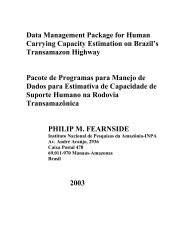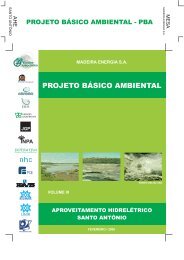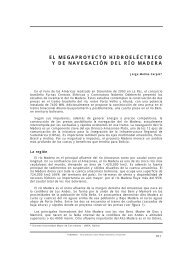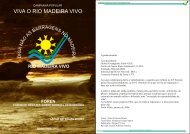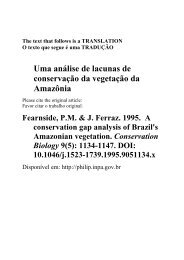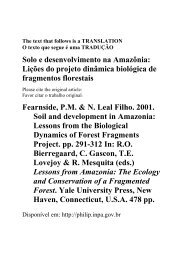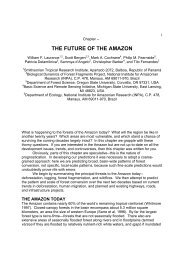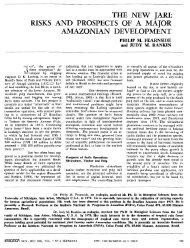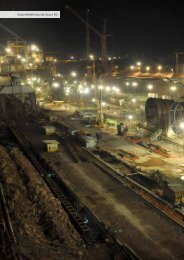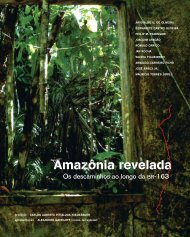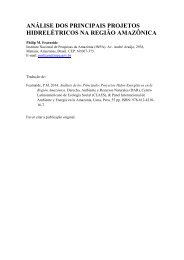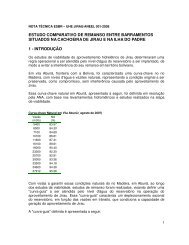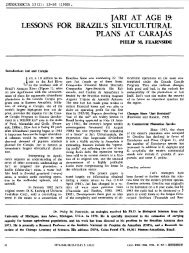- Page 1 and 2:
SUMÁRIO5.2 - MEIO BIÓTICO .......
- Page 3 and 4:
LISTA DE FIGURASFigura 1 - Mapa das
- Page 5 and 6:
Figura 53 - Número esperado de esp
- Page 7 and 8:
Figura 105 - Curva geral de acumula
- Page 9 and 10:
Tabela 28 - Lista da ictiofauna col
- Page 12 and 13:
Figura 2 - Mapa de localização do
- Page 14 and 15:
ocorreu entre os dias 16 e 26 de ja
- Page 16 and 17:
300, foi deslocado para o km 285, a
- Page 18 and 19:
Análise e EstatísticaComo parâme
- Page 20 and 21:
Metodologia da FaunaDelineamento Am
- Page 22 and 23:
Figura 4 - Módulo RAPELD instalado
- Page 24 and 25:
Figura 6 - Detalhe dos módulos RAP
- Page 26 and 27:
máximo fragmentar a serrapilheira,
- Page 28 and 29:
Descrição dos corpos d’água am
- Page 30 and 31:
Figura 7 - Imagens obtidas no levan
- Page 32 and 33:
Em cada um dos quatorze pontos de a
- Page 34 and 35:
Além destas análises, outros fato
- Page 36 and 37:
Figura 8 - Aspecto da disposição
- Page 38 and 39:
de Legler (1960), com aros metálic
- Page 40 and 41:
(2008) e também por meio de vocali
- Page 42 and 43:
testemunho (voucher), permitindo qu
- Page 44 and 45:
questionários estruturados com mor
- Page 46 and 47:
espécies e estimados índices rela
- Page 48 and 49:
pela manhã. Foram utilizados como
- Page 50 and 51:
Categorias : 0 a 20 %= ambientes di
- Page 52 and 53:
Os indivíduos capturados foram pr
- Page 54 and 55:
Curva do coletor estabilizadaUma da
- Page 56 and 57:
demonstraram que o sucesso de captu
- Page 58 and 59:
5.2.2 - Flora- Caracterização da
- Page 60 and 61:
estende-se até as proximidades da
- Page 62 and 63:
Tabela 3 - Tipologia e paisagens oc
- Page 64 and 65:
Estimativa da distribuição das á
- Page 66 and 67:
Tabela 8 - caracterização da vege
- Page 68 and 69:
Tabela 9 - Espécies por famílias
- Page 70 and 71:
Total 29 6 244 27912. Celastraceae
- Page 72 and 73:
Vatairea sericea Ducke/Fava amargos
- Page 74 and 75:
Virola cuspidata Warb. Árvore 4 1
- Page 76 and 77:
Conforme a tabela 9, uma caracterí
- Page 78 and 79:
Figura 16 - Vista da Campina Aberta
- Page 80 and 81:
Caracterização dos estratos não
- Page 82 and 83:
Segue a tabela com os módulos estu
- Page 84 and 85:
O levantamento registrou ainda pter
- Page 86 and 87:
Tabela 12 - Lista das espécies dos
- Page 88 and 89:
2 04.82631° 061.38864° Capim barb
- Page 90 and 91:
3 04.90258° 061.46353° Goiaba de
- Page 92 and 93:
5 05.15958° 061.77399° Buxixu de
- Page 94 and 95:
6 05.31706° 061.99990° Envira pre
- Page 96 and 97:
7 05.45769° 062.10127° Envira fof
- Page 98 and 99:
9 05.77432° 062.30191° Buxixu de
- Page 100 and 101:
10 06.24041° 062.70089° Jurubebã
- Page 102 and 103:
12 06.36838° 062.80546° Vassourin
- Page 104 and 105:
13 06.46168° 062.88400° Faveira c
- Page 106 and 107:
15 07.22557° 063.14320° Patinho r
- Page 108 and 109:
16 07.38075° 063.20164° Poeraria
- Page 110 and 111:
17 07.54858° 063.26407° Murtinha
- Page 112 and 113:
pela tabela 14 que demonstra a conc
- Page 114 and 115:
Curva do coletor (Contato Savana -
- Page 116 and 117:
Tabela 14 - Distribuição dos indi
- Page 118 and 119:
Tabela 15 - Descritores fitossociol
- Page 120 and 121:
Parkia nitida Miq. 53 22 57,54 13,9
- Page 122 and 123:
Rutaceae 51 17 12,16 0,6066 0,33 0,
- Page 124 and 125:
- Espécies endêmicas, raras, amea
- Page 126 and 127:
Em um estudo sobre dez espécies de
- Page 128 and 129:
Tabela 17 - Relação de espécies
- Page 130 and 131:
analépticas)Duroia genipoides Hook
- Page 132 and 133:
Swartzia polyphylla DC. Caesalpinia
- Page 134 and 135:
1. O primeiro extrato é o sub-bosq
- Page 136 and 137:
Tabela 18 - Espécies da Floresta O
- Page 138 and 139:
EFigura 31 - Vista dos cursos de á
- Page 140 and 141:
formação são Virola surinamensis
- Page 142 and 143:
• Formações Pioneiras com influ
- Page 144 and 145:
Na pecuária intensiva, a vegetaç
- Page 146 and 147:
Região da Floresta Ombrófila Aber
- Page 148 and 149:
A palmeira Buriti (Mauritia flexuos
- Page 150 and 151:
Savana arborizada sem floresta de g
- Page 152 and 153:
et al., 1991, apud IBGE, 1992), sen
- Page 154 and 155:
passando por pastagens formadas e e
- Page 156 and 157:
5.2.3 - FaunaA Instrução Normativ
- Page 158 and 159:
Biológica Brasileira (PROBIO), cin
- Page 160 and 161:
As borboletas compreendem um grupo
- Page 162 and 163:
Figura 37 - Número de espécies de
- Page 164 and 165:
Tabela 24 - Abundância dos inverte
- Page 166 and 167:
número pode chegar a 90 espécies
- Page 168 and 169:
Espécies raras normalmente despert
- Page 170 and 171:
Tabela 26 - Freqüência dos gêner
- Page 172 and 173:
Nenhuma espécie de escorpião foi
- Page 174 and 175:
Escorpiões do gênero Teuthraustes
- Page 176 and 177:
Figura 41 - Representação de ambi
- Page 178 and 179:
Igarapés - Um dos componentes mais
- Page 180 and 181:
(Goulding, 1980), com um número es
- Page 182 and 183:
Characiformes foram as mais abundan
- Page 184 and 185:
Anostomus sp 7 lagoAnostomus taenia
- Page 186 and 187:
Moenkhausia cotinho 1 praia e flore
- Page 188 and 189:
anquinha comprida Cyphocharax micro
- Page 190 and 191:
Ituí, tuvira, sarapó Sternarchell
- Page 192 and 193:
Imparfinis sp 1 3 rioCallichthyidae
- Page 194 and 195:
acari-bodo Hypostomus hoplonites 5
- Page 196 and 197:
acará-cupido Biotodoma cupido 3,6
- Page 198 and 199:
Ictiofauna de igarapésOs igarapés
- Page 200 and 201:
Tabela 28 - Lista da ictiofauna col
- Page 202 and 203:
Erythrinus erytrinus traíra,jeju 1
- Page 204 and 205:
Gymnotus sp. 1,5,6,9Gymnotus anguil
- Page 206 and 207:
2%8%0%30%60%ClupeiformesCharaciform
- Page 208 and 209:
Brycon melanopterus Jatuarana NC NC
- Page 210 and 211:
Auchenipterus sp. NC NC Col ---- --
- Page 212 and 213:
As caraterísticas mais relevantes
- Page 214 and 215:
selecionar os exemplares de peixes
- Page 216 and 217:
Ambiente de rios de água brancaN.
- Page 218 and 219:
Riqueza e AbundânciaCharaciformesR
- Page 220 and 221:
Riqueza e Abundância40353025201510
- Page 222 and 223:
largura e extensão muito maior que
- Page 224 and 225:
Hoplias malabaricusIgarapé Goiabal
- Page 226 and 227:
comunidades de peixes igarapés (Si
- Page 228 and 229:
impacto antropogênico e outros alt
- Page 230 and 231: Rio AcaráAcestrorhynchus abbreviat
- Page 232 and 233: Ageneiosus inermisRio RealidadeAuch
- Page 234 and 235: Acestrorhynchus falcirostrisRio Jut
- Page 236 and 237: Entretanto, o padrão de abundânci
- Page 238 and 239: ferramentas. Em nosso estudo, dos 1
- Page 240 and 241: substâncias que chegam ao corpo d
- Page 242 and 243: a alimentação do grupo que foi do
- Page 244 and 245: maparás, também por peixes de esc
- Page 246 and 247: causar um revolvimento dos sediment
- Page 248 and 249: Espécies da Fauna Brasileira Amea
- Page 250 and 251: Ordem: CHARACIFORMESFamília: Chara
- Page 252 and 253: mercados e feiras da região. Não
- Page 254 and 255: piscívora quando adulto, alimentan
- Page 256 and 257: Ordem: SILURIFORMESFamília: Pimelo
- Page 258 and 259: parcelada e fecundação externa. A
- Page 260 and 261: Das espécies encontradas no estudo
- Page 262 and 263: Definição de espécies bioindicad
- Page 264 and 265: poluição, tráfico de embarcaçõ
- Page 266 and 267: área de 4.000 hectares durante um
- Page 268 and 269: Na estação chuvosa, o número de
- Page 270 and 271: Tabela 36 - Lista das espécies de
- Page 272 and 273: 47. Leposoma sp. Calango PT, CT X X
- Page 274 and 275: Tabela 37 - Lista das espécies de
- Page 276 and 277: 47. Leptodactylus knudseni Heyer, 1
- Page 278 and 279: 87. Atractus cf. latifrons (Günthe
- Page 282 and 283: 120Nº de espécimes100806040200Rhi
- Page 284 and 285: (Gymnophthalmidae), Anolis ortoni e
- Page 286 and 287: Viperidae (uma sp.). A contribuiç
- Page 288 and 289: 4Nº de espécimes3210Oxyrhopus mel
- Page 290 and 291: Figura 97 - Jacaré-coroa Paleosuch
- Page 292 and 293: 60,0%50,0%40,0%AnfibiosLagartosSerp
- Page 294 and 295: Dentre as espécies de interesse co
- Page 296 and 297: estudos para verificar se ela pode
- Page 298 and 299: construção de hipóteses que ser
- Page 300 and 301: quando estas deixam a floresta inun
- Page 302 and 303: da região Norte do Brasil: Peltoce
- Page 304 and 305: necessário, portanto, um estudo ap
- Page 306 and 307: numerosos registros novos e até es
- Page 308 and 309: Na literatura ornitológica, o inte
- Page 310 and 311: Espécies ameaçadasQuatro espécie
- Page 312 and 313: outros. Desta forma, é necessário
- Page 314 and 315: áreas com menor ação antrópica.
- Page 316 and 317: • Mamíferos de pequeno porte “
- Page 318 and 319: O Ponto 2 foi o que apresentou maio
- Page 320 and 321: estudos na Amazônia, especialmente
- Page 322 and 323: Figura 110 - Curva de acumulação
- Page 324 and 325: 2) apresentou o maior sucesso de ca
- Page 326 and 327: pode ser explicada, segundo os auto
- Page 328 and 329: aparentemente discrepante. Este dad
- Page 330 and 331:
estudos específicos sobre a sistem
- Page 332 and 333:
dos impactos ambientais gerados pel
- Page 334 and 335:
Tabela 41 - Lista de espécies de m
- Page 336 and 337:
Sciurus pusillus Esquilo cinza 1 P1
- Page 338 and 339:
Tabela 43 - Índice de Linsdale, Fr
- Page 340 and 341:
As espécies com maior número de r
- Page 342 and 343:
também é significativa (P
- Page 344 and 345:
Tabela 49 - Quantidade, tamanho mé
- Page 346 and 347:
manutenção da rodovia (construç
- Page 348 and 349:
foram identificadas 18 espécies; n
- Page 350 and 351:
As informações dos levantamentos
- Page 352 and 353:
O fato de não ser encontrada corre
- Page 354 and 355:
DiscussãoConsiderando o grupo de p
- Page 356 and 357:
espécies utilizadas neste comérci
- Page 358 and 359:
Mazurek et al., (2000) e (Von-Muhle
- Page 360 and 361:
Comércio de Caça na área urbana
- Page 362 and 363:
Entretanto, o uso de armas de fogo
- Page 364 and 365:
Tabela 55 - Unidades de Conservaç
- Page 366 and 367:
- Unidades de Conservação Estadua
- Page 368 and 369:
pode ser realizado de voadeira, ess
- Page 370 and 371:
pescadores profissionais em troca d
- Page 372 and 373:
sistema de sinalização é, atualm
- Page 374 and 375:
financiamento para apoiar nas açõ
- Page 376 and 377:
Porto Velho, com o objetivo discust
- Page 378 and 379:
5. Direcionamento ao uso sustentáv
- Page 380 and 381:
unidades de conservação e a ampli
- Page 382 and 383:
Tabela 56 - Comparando UC’s estad
- Page 384 and 385:
5.2.4.5 - Possíveis Interações,
- Page 386 and 387:
esultar em efeito positivo. Entreta
- Page 388 and 389:
Freqüentemente animais exploram gr
- Page 390 and 391:
na implementação de programas de
- Page 392 and 393:
4,7%, enquanto a proporção de des
- Page 394 and 395:
Tabela 58 - Unidades de Conservaç
- Page 396 and 397:
Vale ressaltar que a proposta surgi
- Page 398 and 399:
assegurar a manutenção do ecossis
- Page 400 and 401:
simpatria na região): Considerada
- Page 402 and 403:
originam nestas áreas apresentam
- Page 404 and 405:
A análise de mamíferos evidenciou
- Page 406 and 407:
Anexo II. Questionários- Question
- Page 408 and 409:
Anexo III. Espécies da Flora que o
- Page 410 and 411:
Anexo V. Lista de espécies mais fr
- Page 412 and 413:
Anexo VII. As 743 espécies de aves
- Page 414 and 415:
Anexo IX. Espécies de Morcegos reg



